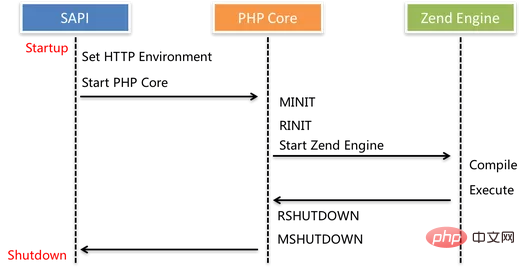Why run Laravel on Swoole?
Why run Laravel on Swoole? Because using Swoole can speed up Laravel applications. The following article will talk to you about how to use Laravel on Swoole. I hope it will be helpful to you!

#Swoole is a production-grade asynchronous programming framework developed for PHP. It is a purely C-developed extension that allows PHP developers to write high-performance, scalable concurrent TCP, UDP, Unix socket, HTTP, and WebSocket services in PHP without having to have too much non-blocking I/O programming. and low-level Linux kernel knowledge. You can think of Swoole as NodeJS, but with higher performance for PHP. [Recommended learning: swoole tutorial]
Why run Laravel on Swoole?
The following figure shows the life cycle of PHP. As you can see, every time you run a PHP script, PHP needs to initialize modules and start the Zend engine for your runtime environment. And compile PHP scripts into OpCodes for Zend engine execution.
However, such a life cycle needs to be executed every time a request is made. Because the environment created by a single request will be destroyed immediately after the request execution is completed.
In other words, in the traditional PHP life cycle, a lot of time is wasted creating and destroying resources for script execution. Imagine a framework like Laravel, how many Why run Laravel on Swoole?s need to be loaded in each request? At the same time, a lot of I/O operations are wasted

So if we use Swoole to build a Application-level Server, and all script Why run Laravel on Swoole?s can be saved in memory after being loaded once? This is why we need to try running Laravel on Swoole. Swoole can provide powerful performance while Laravel can provide elegant code structure usage. These two are really a perfect combination!
Installation
The following are the main features of swooletw/laravel-swoole:
- Run Laravel/Lumen application in Swoole
- Excellent performance improved to 30x
- Sandbox mode isolation application container
- Support running WebSocket server in Laravel application
- Support
Socket.ioProtocol - Support Swoole table cross-process sharing
Use Composer to install:
$ composer require swooletw/laravel-swoole
This package depends on At Swoole. Before using this package, make sure your machine has the correct Swoole installed. Use the following command to quickly install (linux):
pecl install swoole
After installing this extension, you need to edit php.ini and add extension=swoole.so.
php -i | grep php.ini # check the php.ini Why run Laravel on Swoole? location sudo echo "extension=swoole.so" >> php.ini # add the extension=swoole.so to the end of php.ini php -m | grep swoole # check if the swoole extension has been enabled
Visit the official website for more information.
Note: Swoole currently only supports Linux and OSX. Windows servers are not supported yet.
Then, add the service provider:
If you use Laravel, add the service provider in the config/app.php service provider array:
[
'providers' => [
SwooleTW\Http\LaravelServiceProvider::class,
],
] If you use Lumen, please add the following code to bootstrap/app.php:
$app->register(SwooleTW\Http\LumenServiceProvider::class);
This package supports the package auto-discovery mechanism. If you are running Laravel 5.5 or above, you can skip this step.
Get it up and running
Now, you can execute the following command to start the Swoole HTTP service.
$ php artisan swoole:http start
Then you can see the following information:
Starting swoole http server... Swoole http server started: <http://127.0.0.1:1215>
You can now enter the Laravel application by visiting http://127.0.0.1:1215.
Benchmark test
Using MacBook Air 13-inch (produced in 2015) and clean Lumen 5.5 project test:
Benchmark test tool: wrk
wrk -t4 -c100 http://your.app
Nginx based on FPM
Running 10s test @ http://lumen.app:9999
4 threads and 100 connections
Thread Stats Avg Stdev Max +/- Stdev
Latency 1.14s 191.03ms 1.40s 90.31%
Req/Sec 22.65 10.65 50.00 65.31%
815 requests in 10.07s, 223.65KB read
Requests/sec: 80.93
Transfer/sec: 22.21KBSwoole HTTP service
Running 10s test @ http://127.0.0.1:1215
4 threads and 100 connections
Thread Stats Avg Stdev Max +/- Stdev
Latency 11.58ms 4.74ms 68.73ms 81.63%
Req/Sec 2.19k 357.43 2.90k 69.50%
87879 requests in 10.08s, 15.67MB read
Requests/sec: 8717.00
Transfer/sec: 1.55MBMore Information
View the official package in Github Repo, and you can also refer to Official Documentation for more information.
English original address: https://laravel-news.com/laravel-swoole?
[Related recommendations: laravel video tutorial]
The above is the detailed content of Why run Laravel on Swoole?. For more information, please follow other related articles on the PHP Chinese website!

Hot AI Tools

Undresser.AI Undress
AI-powered app for creating realistic nude photos

AI Clothes Remover
Online AI tool for removing clothes from photos.

Undress AI Tool
Undress images for free

Clothoff.io
AI clothes remover

AI Hentai Generator
Generate AI Hentai for free.

Hot Article

Hot Tools

Notepad++7.3.1
Easy-to-use and free code editor

SublimeText3 Chinese version
Chinese version, very easy to use

Zend Studio 13.0.1
Powerful PHP integrated development environment

Dreamweaver CS6
Visual web development tools

SublimeText3 Mac version
God-level code editing software (SublimeText3)

Hot Topics
 How to use object-relational mapping (ORM) in PHP to simplify database operations?
May 07, 2024 am 08:39 AM
How to use object-relational mapping (ORM) in PHP to simplify database operations?
May 07, 2024 am 08:39 AM
Database operations in PHP are simplified using ORM, which maps objects into relational databases. EloquentORM in Laravel allows you to interact with the database using object-oriented syntax. You can use ORM by defining model classes, using Eloquent methods, or building a blog system in practice.
 Analysis of the advantages and disadvantages of PHP unit testing tools
May 06, 2024 pm 10:51 PM
Analysis of the advantages and disadvantages of PHP unit testing tools
May 06, 2024 pm 10:51 PM
PHP unit testing tool analysis: PHPUnit: suitable for large projects, provides comprehensive functionality and is easy to install, but may be verbose and slow. PHPUnitWrapper: suitable for small projects, easy to use, optimized for Lumen/Laravel, but has limited functionality, does not provide code coverage analysis, and has limited community support.
 Laravel - Artisan Commands
Aug 27, 2024 am 10:51 AM
Laravel - Artisan Commands
Aug 27, 2024 am 10:51 AM
Laravel - Artisan Commands - Laravel 5.7 comes with new way of treating and testing new commands. It includes a new feature of testing artisan commands and the demonstration is mentioned below ?
 Comparison of the latest versions of Laravel and CodeIgniter
Jun 05, 2024 pm 05:29 PM
Comparison of the latest versions of Laravel and CodeIgniter
Jun 05, 2024 pm 05:29 PM
The latest versions of Laravel 9 and CodeIgniter 4 provide updated features and improvements. Laravel9 adopts MVC architecture and provides functions such as database migration, authentication and template engine. CodeIgniter4 uses HMVC architecture to provide routing, ORM and caching. In terms of performance, Laravel9's service provider-based design pattern and CodeIgniter4's lightweight framework give it excellent performance. In practical applications, Laravel9 is suitable for complex projects that require flexibility and powerful functions, while CodeIgniter4 is suitable for rapid development and small applications.
 How do the data processing capabilities in Laravel and CodeIgniter compare?
Jun 01, 2024 pm 01:34 PM
How do the data processing capabilities in Laravel and CodeIgniter compare?
Jun 01, 2024 pm 01:34 PM
Compare the data processing capabilities of Laravel and CodeIgniter: ORM: Laravel uses EloquentORM, which provides class-object relational mapping, while CodeIgniter uses ActiveRecord to represent the database model as a subclass of PHP classes. Query builder: Laravel has a flexible chained query API, while CodeIgniter’s query builder is simpler and array-based. Data validation: Laravel provides a Validator class that supports custom validation rules, while CodeIgniter has less built-in validation functions and requires manual coding of custom rules. Practical case: User registration example shows Lar
 Which one is more beginner-friendly, Laravel or CodeIgniter?
Jun 05, 2024 pm 07:50 PM
Which one is more beginner-friendly, Laravel or CodeIgniter?
Jun 05, 2024 pm 07:50 PM
For beginners, CodeIgniter has a gentler learning curve and fewer features, but covers basic needs. Laravel offers a wider feature set but has a slightly steeper learning curve. In terms of performance, both Laravel and CodeIgniter perform well. Laravel has more extensive documentation and active community support, while CodeIgniter is simpler, lightweight, and has strong security features. In the practical case of building a blogging application, Laravel's EloquentORM simplifies data manipulation, while CodeIgniter requires more manual configuration.
 PHP code unit testing and integration testing
May 07, 2024 am 08:00 AM
PHP code unit testing and integration testing
May 07, 2024 am 08:00 AM
PHP Unit and Integration Testing Guide Unit Testing: Focus on a single unit of code or function and use PHPUnit to create test case classes for verification. Integration testing: Pay attention to how multiple code units work together, and use PHPUnit's setUp() and tearDown() methods to set up and clean up the test environment. Practical case: Use PHPUnit to perform unit and integration testing in Laravel applications, including creating databases, starting servers, and writing test code.
 Laravel vs CodeIgniter: Which framework is better for large projects?
Jun 04, 2024 am 09:09 AM
Laravel vs CodeIgniter: Which framework is better for large projects?
Jun 04, 2024 am 09:09 AM
When choosing a framework for large projects, Laravel and CodeIgniter each have their own advantages. Laravel is designed for enterprise-level applications, offering modular design, dependency injection, and a powerful feature set. CodeIgniter is a lightweight framework more suitable for small to medium-sized projects, emphasizing speed and ease of use. For large projects with complex requirements and a large number of users, Laravel's power and scalability are more suitable. For simple projects or situations with limited resources, CodeIgniter's lightweight and rapid development capabilities are more ideal.






